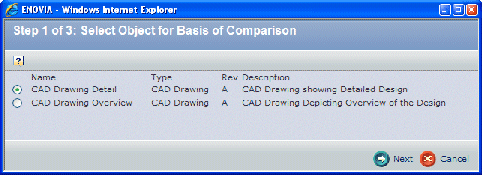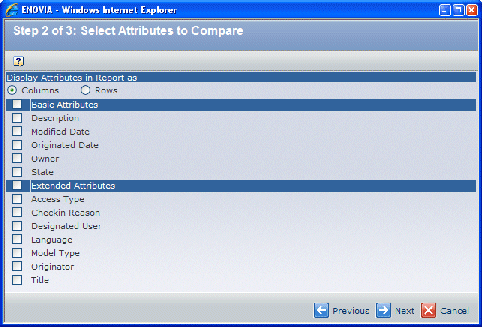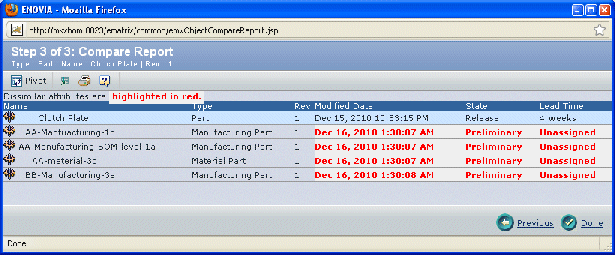From the Search Results page, check two or more objects to compare.
Click  from the page toolbar
of a Search Results page.
from the page toolbar
of a Search Results page.
The Select Object for Basis of Comparison page opens.

If any of the fields include an mxLink (hyperlink to an ENOVIA object),
that field is converted to straight text and cannot be clicked.
Click the button next to the object you want to use as a basis for comparison,
that is, the object that you want to compare other objects to. For example,
if you want to compare cost or effectivity dates, select an object that
contains those attributes.
Click Next. The Select Attributes page opens.
- The Basic Attributes section shows attributes common to all objects:
description, modified date, originated date, owner, and state.
- The Extended Attributes section shows additional attributes specific
to the type of object you selected as a basis for comparison.

Select whether you want attributes in the report displayed in Columns
or Rows.
You can change the display when the report is shown using the Pivot
command.
Check the attributes that you want to appear on the comparison report.
Click Next.
The Comparison Report page opens. Dissimilar attributes are highlighted
in red. Type, name and revision always appear on the comparison report
and differences in these are not highlighted.
Attributes with units of measure compare values based on the default
units stored in the database. The default units and displayed units may
differ, and the objects in two rows in the report may have different
units. However, if the values are equivalent, such as 1000 gm and 1 kg,
then the report will not mark these values as different.
The comparison between the attribute values is done after trimming
any leading or trailing blank spaces. Therefore, no difference is highlighted
in values with or without leading or trailing blanks. Also, no value
(Null) is considered as empty string.

For attributes configured with units of measure, the report shows the
values with the units of measure as originally entered, followed by the
values with your preferred units, such as:
50.0 Kilogram (110.231123802 Pound)
If the units are the same, you only see one value.
To select other attributes to compare or other objects for comparison, click Previous and repeat
steps 5 through 7.
Work with the comparison report:
- To change the attribute headings from columns to rows or vice versa, click Pivot from the
page toolbar.
- To export the report data, click
 from the page toolbar. For details, see . Differences are
not highlighted in exported data.
from the page toolbar. For details, see . Differences are
not highlighted in exported data.
- To print the page, click
 in the page toolbar and use the browser's Print button. Differences are highlighted in gray on the printer-friendly
page.
in the page toolbar and use the browser's Print button. Differences are highlighted in gray on the printer-friendly
page.
Click Done to close the report page.